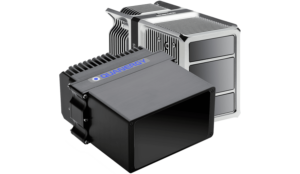 Quanergy Systems, Inc. has completed a successful demonstration of its S3 Series LiDAR, a true solid state LiDAR sensor using an industry-first Optical Phased Array (OPA) technology and a scalable CMOS silicon manufacturing process for cost-effective, mass-market production.
Quanergy Systems, Inc. has completed a successful demonstration of its S3 Series LiDAR, a true solid state LiDAR sensor using an industry-first Optical Phased Array (OPA) technology and a scalable CMOS silicon manufacturing process for cost-effective, mass-market production.
The demonstration, conducted in partnership with Santa Clara University’s School of Engineering, Robotics Department, was completed with an S3-4, a solid-state LiDAR test platform with four scanning beams. The test included the tracking and identification of several difficult-to-detect objects, including a target with 10% reflectivity mounted on a driving vehicle, a black SUV, and a person with dark clothes. All these objects, initially located 100 meters from the test platform, were successfully tracked by the S3-4 test sensor as they moved to 130 meters.
“Quanergy’s CMOS-based OPA technology is very promising for both automotive and industrial applications,” said Dr. Christopher Kitts, Associate Dean of Santa Clara University, School of Engineering. “Quanergy’s OPA architecture with electronic beam steering and no moving parts, is ideally suited for many high-vibration outdoor mobility applications, from passenger vehicles to challenging robotics applications like agricultural and construction unmanned guided vehicles. Its Adaptive Zoom capability is extremely innovative and it can enable a whole new set of applications.”
Quanergy’s S3 Series LiDAR sensor is designed to meet the most stringent automotive requirements for object detection and collision avoidance. The sensor’s unique electronic beam steering without any moving parts offers immunity to shock and vibration. The S3 Series provides over 100,000 hours mean time between failures, and it is targeting a price of $500 for mass-market production.
“Quanergy is continuing to advance the performance of its OPA-based solid-state technology towards relevant use cases for Internet of Things (IoT) and mobility applications. We are very excited about this demonstration of 130-meter detection range because it was not only achieved in full daylight with a 10% reflectivity target but it was also extended to real world objects like a pedestrian and a black vehicle,” said Dr. Tianyue Yu, Quanergy Co-founder and Chief Development Officer. “The multi-beam setup used provides higher density coverage and builds on the single beam test we conducted in July, underscoring the rapid rate of evolution of our solid-state platform development.”


















